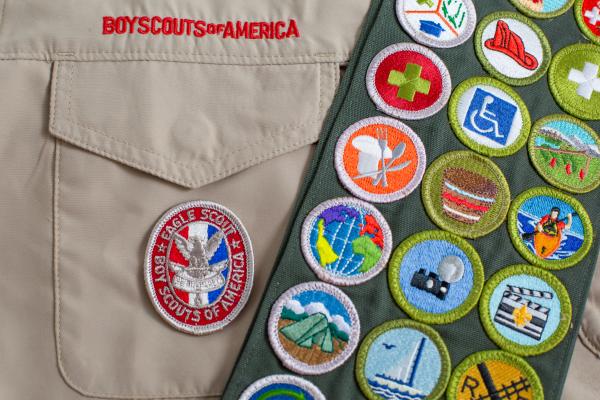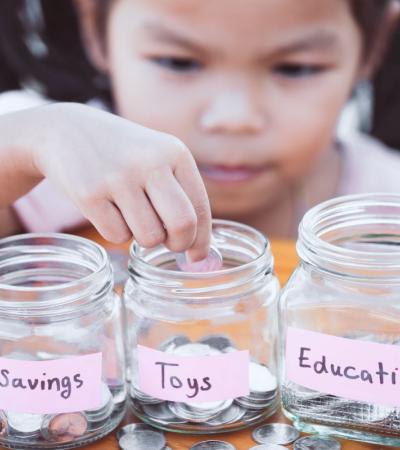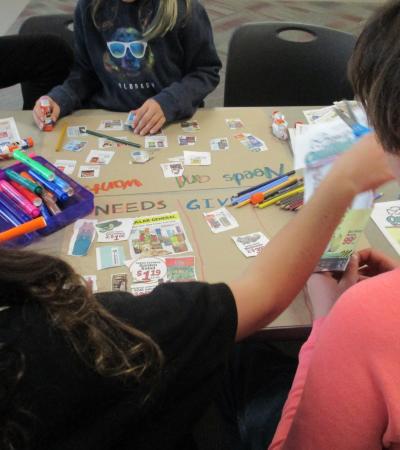“Things cost more than you think.”
“There are more wants in the world than needs.”
“I like to save for my future.”

Those wise words of financial advice from grade-schoolers were posted on a bulletin board at the Northport Public Library in New York in 2021. The board, titled “Feed Our Cash Cow Your Comments,” featured a giant drawing of a spotted white cow covered in gold paper coins, each printed with words from Scouts and other kids who visited the library to learn about financial literacy.
One Scout leader emailed the library after the program: “The librarian did a great job showing us and explaining everything. Thank you for making us have a fun way to earn our philanthropy/financial literacy badge.
The Scouts in this troop and others around the country earned their badges through activities associated with Thinking Money for Kids, an initiative of the American Library Association and the FINRA (Financial Industry Regulatory Authority) Investor Education Foundation that strives to teach children and their parents, caregivers and educators about financial topics — like saving, spending, sharing and budgeting — in a way that is both meaningful and fun.
Through Thinking Money for Kids, ALA and the FINRA Foundation offer program resources, traveling exhibitions and other materials for libraries, and many other reputable organizations offer curricula as well. Northport Library’s efforts resulted in the participation of 18 Scout groups.
Several Girl Scout and Boy Scout badges are available for all age levels that require activities related to financial literacy, including such topics as budgeting, saving, spending, savvy shopping, money management and entrepreneurship. Scouts can earn the badges in one or more visits to the library, with librarians or Scout leaders coming up with their own programs or following easy-to-use activity plans provided by the national Scouting organizations.
Scouts at the library
Robbee Tonubbee, library director at the Donald W. Reynolds Community Center & Library in Durant, Oklahoma, worked with Daisies, Brownies, Juniors and Cadettes (Girls Scout levels ranging from kindergarten through eighth grade) to help them earn financial literacy badges.
As a former teacher, Tonubbee said she struggled to find math curriculum programming related to financial literacy for kids younger than 12, but “5- 6-, 7- and 8-year-olds can think about money.” She was impressed with the detailed lesson plans provided by the Girls Scouts featuring suggested activities for earning badges.
“Don’t feel like you have to reinvent the wheel,” Tonubbee said. “Somebody has written good-quality curriculum. The purchase from the Girl Scouts was well worth it” (a “badge requirement” booklet costs $3 for each badge). Her library even purchased the badges for the Scouts ($3.50 each) and hosted a badge ceremony, although other libraries required the Scouts to pay for those expenses.
Lori Hugley, head of the Kokomo-Howard County Public Library Branches in Indiana, said most of the badge activities can be completed in one session. The libraries she leads already have ongoing relationships with Scouts to earn other badges, and Girl Scouts meet regularly at the library, so reaching out to Scout leaders was easy, she said. “We looked at the badge requirements, then planned activities to make sure we hit all the high points, or asked the leaders if we could create something for them.”
Working with Scouts is “easier than you might realize,” said Christine Farrugia, children’s librarian at the Northport-East Northport Public Library. Farrugia, who has also been a Girl and Boy Scout leader, said librarians can get involved as little or as much as they want when it comes to guiding activities.
Here are some of the successful activities libraries have used with Scout troops to help them earn badges or just learn about financial literacy, organized by topic:
Budgeting
1. Create “Spend, Save and Give” banks or jars
This practical craft project for all ages is a way to help Scouts visually understand the options they have to responsibly divide up any money they earn or receive as gifts. The project is an opportunity to discuss the difference between personal wants and needs, and the importance of saving as well as generosity and donating to others. Using materials as simple as a cardboard shoebox divided into three sections, or three separate recycled glass food jars, Scouts can label each section or jar with “Spend,” “Save” and “Give” (or “Donate” or “Share”), then decorate as they please, perhaps even adding images of items they want to purchase or save for, or of an organization or person they want to give earnings away to. At home, they can add actual money to each respective slot or jar. The University of Minnesota Extension offers simple directions, including a list of supplies, for either craft.
2. Invite financial educators to give a talk
The Pioneer Library System in Norman, Oklahoma, incorporated the money topics “earn, save, spend and share” in a program presented by financial educators from a local federal credit union the library had worked with before. Community banks and credit unions often have staff who are eager to provide free community education programs, and sometimes can provide learning materials.
3. Plan a restaurant budget
The Shreve Memorial Library in Shreveport, Louisiana, offered a two-session program in which participants first worked out a budget for a make-believe restaurant with recipes that included the costs for real-life ingredients. During the second session, they made a low-cost, kid-friendly, no-bake recipe.
Currency
4. Ask a historian, tax expert or police officer to talk about cash
The M.R. Davis Public Library in Southaven, Mississippi, offered several speaker programs for all ages that addressed different aspects of currency in the U.S. and how it works. The curator of a local history museum talked about why we use money and its role in our society, and how banking developed in the United States. An IRS representative explained how the IRS collects money and the ways those funds are used in the local community. A police officer brought in counterfeit money to discuss what fake currency is and how it harms local businesses and consumers.
5. Design dollar bills or coins
Any discussion about the history of money, and how currency works, can include a project where Scouts design their own dollar bills using paper and writing tools, or coins using clay and different size cookie cutters. The Smithsonian Natural Museum of American History offers a “Designing Money” guide.
6. Make change
Several librarians said they were surprised how little Scouts of all ages knew about coins and dollars — they were accustomed to seeing their parents and others pay for things using a credit or debit card, or a digital app. Many did not know how to distinguish between different types of coins and bills, so activities where they had to make change “were extremely beneficial, even for older Scouts,” said Hugley, who also incorporated information on percentages so kids could understand how much something costs if sold at a 25 percent or 75 percent discount.
Spending
7. Offer pretend money for “buying” supplies to make a craft
Several libraries found success offering pretend money that Scouts could use to purchase supplies for craft projects. Some libraries gave participants opportunities to earn fake dollars and coins by solving money-themed puzzles; others gave them a set amount of false currency to spend, and they had to work within their allotted “budget” to purchase stickers, sequins, ribbon, feathers, art canvases, etc. Fancier supplies cost more, so participants had to prioritize what they wanted. The Pioneer Library System also offered supplies for “rent,” such as crayons and glue sticks, which helped participants understand the different between buying and renting.
8. Host a clothing redesign or swap
The Kokomo-Howard County Public Library hosted activities for two age groups (grades 3-5 and grades 6-12) that taught them to be smart clothes shoppers/swappers. For younger kids, the library asked participants to bring in an article of clothing they didn’t wear often, or purchased at a thrift shop, then taught them how to refresh and redesign the older piece into something new. For tweens and teens, the library hosted a clothing swap called Leap into a New Wardrobe that invited participants to bring in clothes they no longer wanted to swap with someone else for free.
9. Comparison shop
The M.R. Davis Public Library offered a badge workshop for Girls Scout Brownies (grades 2-3) and Juniors (grades 4-5) where participants shopped for clothes using play money, and used two different grocery store ads to comparison shop.
Earning
10. Create financial vision boards
The West Regional Branch of the Mobile Public Library, in Mobile, Alabama, hosted a group of Girl Scouts who made vision boards that focused on how they would earn money in the future.
11. Teach older Scouts about job income
The Donald W. Reynolds Library presented a badge program for Girl Scout Juniors (grades 4-5) and Cadettes (grades 6-8) that discussed income tax, paycheck withholdings, saving vs. investing, and safely navigating the internet and personal information online.
Book recommendations
The ALA and the FINRA Foundation created “Thinking Money for All Kids,” an inclusive guide to books that teach about money, including picture books, fiction and nonfiction titles for young readers of all ages.
For Scout activities, some of these books can be used in conjunction with other activities, depending on the age group and topic. The picture book "A Chair for My Mother," for example, can be paired with a craft to make jars for spending, saving, and giving; in the story, a little girl saves money in a jar so she can eventually buy a new chair for her hardworking mother to sit on when she comes home.
"Camping, Here I Come: Keeping a Budget" by Lisa Bullard, also for younger Scouts, is about a boy who needs to sell enough candy to go on a club camping trip, a scenario most Scouts can probably relate to.
"The Lemonade War" by Jacqueline Davies, recommended for ages 8-12, is about a brother and sister who battle to see who can sell the most lemonade in the summer before school starts. It can be used to discuss how to succeed at starting a business.
Other programming ideas and resources
More guidance on how to develop a financial education program and discover trusted sources of unbiased financial information is available from the following sources:
ALA’s Reference and User Services Association (RUSA) has published these guidelines, with support from the Institute of Museum and Library Services (IMLS).
RUSA maintains a Financial Literacy Interest Group for sharing ideas about programming, reference assistance, collections and other library services that support patrons’ information needs for financial decision-making.
This guide created by the ALA Office of Research & Evaluation, and funded by the FINRA Foundation, features a wealth of recommended financial literacy-related books, websites, magazines, journals, databases and resources for professional development.



